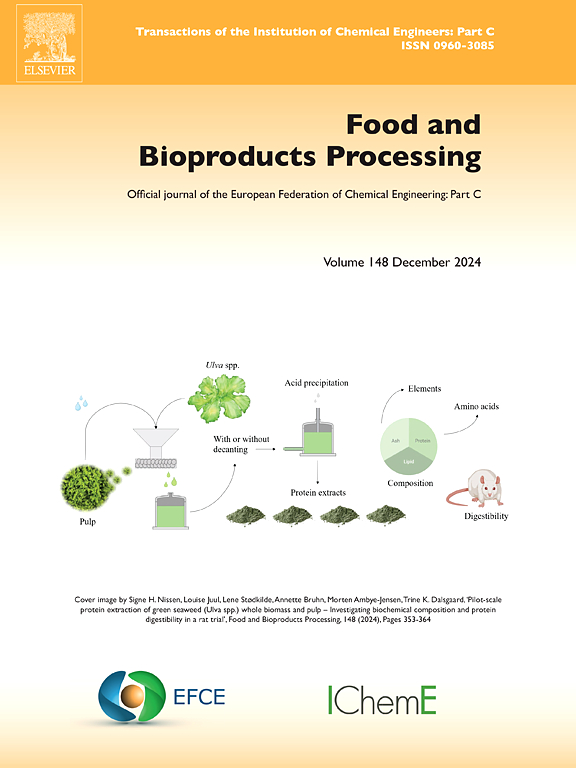Morphometry and textural surface properties of heat induced whey protein microparticles
IF 3.4
2区 农林科学
Q2 BIOTECHNOLOGY & APPLIED MICROBIOLOGY
引用次数: 0
Abstract
The present work focuses on the study of four key factors controlling the process of whey protein microparticulation: protein suspension concentration (%WPI 2.5 % vs. 5.0 %); medium acidity (pH 4.5 vs. 5.5); denaturation temperature (80°C vs. 90°C); and particle size reduction method (180 bar x 1, 2 or 3 cycle(s); 1800 bar x 1 cycle). The effects of the microparticulation process were studied by analysing the degree of protein aggregation, morphometry, and surface textural characteristics of the microparticles. The results obtained indicate that the most favourable treatments to achieve a higher proportion of particles within the optimal range required by the food industry (1–10 µm) can be obtained by gentle protein denaturation (80°C) using a medium with a pH lower than the isoelectric point of β-lactoglobulin and moderate concentrations of whey protein (2.5–5.0 %). Under these premises, it is necessary to use a high intensity particle size reduction method (1800 bar) to achieve the average diameter and the adequate homogeneity in a consistent fashion.
热诱导乳清蛋白微粒的形态计量学和结构表面特性
本研究重点研究了控制乳清蛋白微颗粒化过程的四个关键因素:蛋白悬浮液浓度(%WPI 2.5 % vs. 5.0 %);中等酸度(pH 4.5 vs. 5.5);变性温度(80℃vs. 90℃);和粒度减小方法(180 bar × 1、2或3个循环(s);1800 bar x 1 cycle)。通过分析微颗粒的蛋白质聚集度、形态和表面纹理特征,研究了微颗粒化过程的影响。结果表明,要在食品工业要求的最佳范围内(1-10 µm)获得较高的颗粒比例,最有利的处理方法是使用pH低于β-乳球蛋白等电点的培养基和中等浓度的乳清蛋白(2.5-5.0 %)进行温和的蛋白质变性(80°C)。在这些前提下,有必要使用高强度粒度减小方法(1800 bar)以一致的方式达到平均直径和足够的均匀性。
本文章由计算机程序翻译,如有差异,请以英文原文为准。
求助全文
约1分钟内获得全文
求助全文
来源期刊

Food and Bioproducts Processing
工程技术-工程:化工
CiteScore
9.70
自引率
4.30%
发文量
115
审稿时长
24 days
期刊介绍:
Official Journal of the European Federation of Chemical Engineering:
Part C
FBP aims to be the principal international journal for publication of high quality, original papers in the branches of engineering and science dedicated to the safe processing of biological products. It is the only journal to exploit the synergy between biotechnology, bioprocessing and food engineering.
Papers showing how research results can be used in engineering design, and accounts of experimental or theoretical research work bringing new perspectives to established principles, highlighting unsolved problems or indicating directions for future research, are particularly welcome. Contributions that deal with new developments in equipment or processes and that can be given quantitative expression are encouraged. The journal is especially interested in papers that extend the boundaries of food and bioproducts processing.
The journal has a strong emphasis on the interface between engineering and food or bioproducts. Papers that are not likely to be published are those:
• Primarily concerned with food formulation
• That use experimental design techniques to obtain response surfaces but gain little insight from them
• That are empirical and ignore established mechanistic models, e.g., empirical drying curves
• That are primarily concerned about sensory evaluation and colour
• Concern the extraction, encapsulation and/or antioxidant activity of a specific biological material without providing insight that could be applied to a similar but different material,
• Containing only chemical analyses of biological materials.
 求助内容:
求助内容: 应助结果提醒方式:
应助结果提醒方式:


